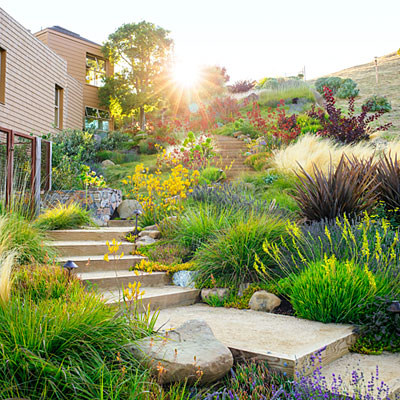
Water only when necessary and keep the soil mulched. Watering deeply, but less often, encourages roots to move deeper into the soil where it’s cooler and moist. Get to know your soil; sandy soils need more frequent watering than clay. Water in the early morning if allowed to avoid evaporation in the heat of the day. Only water in the evenings in areas where fungal infections aren’t a problem.
Direct water to the root zone by inserting several hollow pipes (3–5cm rigid, plastic irrigation pipes work well) around trees and large shrubs, but not right next to the trunk or stem. Place a dowel in the pipe when pushing it in to prevent it from filling up with soil. Remove the dowel once the pipe is in place and water through the pipe.
Make holes (using a needle heated over a flame) in the bottom of several two-litre cold drink bottles and bury these around the root zone. Pour water directly into the bottles to encourage plants to develop a deep drought-resistant root system.
Create dams or reservoirs around plants so the soil around the perimeter is lower than in the middle. This way water is absorbed slowly and flows to the roots and not the trunk or stem.
Drip irrigation systems are more efficient than overhead systems and can cut down water consumption by 70%. With sprinklers and micro-jet sprays, a lot of water is blown away, especially on windy days. Fit automated irrigation systems with rain sensors and adjust the settings according to the seasons and rainfall. .
. To reduce your water bills, replace plants that need a lot of water with low water users. Ideally only 10–15% of all your plants should have high water requirements. Plant these together in a high water zone, preferably near the house or patio. Many plants can adapt to periods of little or no water so group these together.
About 20–30% of your plants can be medium users, planted in a separate zone. The remaining 50% should have low water requirements. Plant them in low water zones away from the house and in exposed areas. If you can create ‘no water’ zones, where plants are totally reliant on rainwater, you can make further savings. Select plants compatible with the climate and rainfall pattern. Don’t plant shrubs or trees from winter-rainfall areas in summer-rainfall areas and vice versa. Many plants from the Eastern Cape, like tecoma and plumbago, are however, suitable for both climatic regions.
Look for plants that store water in their leaves, such as succulents and aloes, in their stems, such as the Sabi star (adenium) and spekboom (Portulacaria afra), or underground in corms or bulbs, for instance, the March lily and agapanthus. Plants with grey foliage reflect the sun and often have fine or hairy leaves which minimise evaporation; they’re also usually more drought tolerant. .
Don’t transplant shrubs and trees during a drought period as they need extra water to survive the move. Don’t feed or fertilise plants during dry periods as new growth requires additional water. Spray plants with Wilt-Pruf to reduce loss of water through the leaves. For more water-saving tips, visit waterwise.co.za. .
Shrubs: Frangipani, cistus, dodonaea, plumbago, rosemary, westringia, strelitzia, Carissa spp., coleonema (confetti bush) and buddleja. . Groundcovers: Arcotis, gazanias, Plectranthus neochilus, vygies, silver carpet (Dymondia margaretae), lamb’s ear (Stachys byzantina), everlastings like Helichrysum petiolare, blue daisy (Felicia amelloides) and Erigeron karvinskianus. . Bulbs and corms: Agapanthus, dietes, tulbaghia, asparagus fern, pineapple flower (Eucomis spp.), clivia, Gladiolus dalenii, watsonia, dianella and renga-renga lily (Arthropodium cirratum).
Perennials: Echium candicans, salvia, pelargoniums, blue statice (Limonium perezii), Mother-in-law’s tongue (Sansevieria spp.), achillea or tansy, bromeliads, Ballota africana, Euphorbia spp., Gaura lindheimeri, Dusty Miller and verbascum. . Succulents: Aloes, crassulas, agaves, kalanchoe, echeveria, Senecio spp., Bulbine frutescens, century plant (Agave attenuata), Aeonium spp. and vygies like lampranthus, ruschia, carpobrotus and drosanthemum. . C/O GARDEN & HOME SOURCES: (http://www.DURATURFSA.CO.ZA) (http://www.JOJOTANKS.CO.ZA) (http://www.RAINQUEENTANKS.CO.ZA) (http://www.TERRAFORCE.COM)
Smallholdings for sale on Facebook - Stay in the loop
Smallholdings on FB - News and Updates from the horses mouth
Direct listings right here - buying or selling we can help YOU